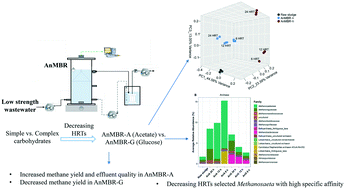Performance of AnMBRs treating low strength wastewater with different carbon sources at decreasing HRTs and its linkage to Methanosaeta with high specific affinity†
Abstract
Hydraulic retention times (HRTs) may reach a minimum limit in anaerobic membrane bioreactor (AnMBR) wastewater treatment because of membrane fouling and possible mass transfer limitations involved in anaerobic treatment processes. This study compared the overall treatment performance and methanogenic populations in AnMBRs treating low strength wastewater containing simple (acetate; denoted in the bioreactor as AnMBR-A) and complex carbohydrates (glucose; AnMBR-G) at decreasing HRTs. At the influent chemical oxygen demand (COD) concentration of 500 mg L−1, as HRT decreased from 24 to 12, and to 6 h, the effluent quality in AnMBR-A improved from 32 ± 13 to 21 ± 13, and to 13 ± 5 mg COD per L, respectively, while its methane yield increased from 0.209 ± 0.007 to 0.215 ± 0.006, and to 0.225 ± 0.003 mg CH4-COD per mg CODremoved, respectively. In AnMBR-G, while the effluent COD remained low (from 40 ± 10 to 23 ± 10 mg L−1), methane yield decreased from 0.234 ± 0.012 to 0.178 ± 0.012 mg CH4-COD per mg CODremoved, which was linked to the decrease in methanogenic population. Specifically, although Methanosaeta with high specific affinity dominated at short HRTs in the AnMBR, its population in AnMBR-G was only 11.4% of that in AnMBR-A at the HRT of 6 h. Detailed mass transfer calculation suggests that the potential mass transfer limitation at decreasing HRTs is mainly caused by slow biochemical reactions (e.g., methanogenesis). As high organic loading may result in organic acid accumulation and methanogenesis inhibition, the results suggest that minimum HRTs should be considered for maintaining enough Methanosaeta with high specific affinity in low strength wastewater treatment.



 Please wait while we load your content...
Please wait while we load your content...